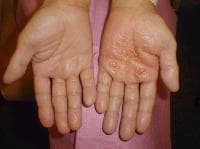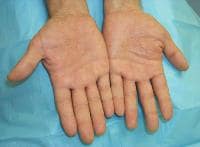Dyshidrotic Eczema
- Author: Sadegh Amini, MD; Chief Editor: Dirk M Elsto
Background
Dyshidrotic eczema is a type of eczema (dermatitis) of unknown cause that is characterized by a pruritic vesicular eruption on the fingers, palms, and soles. The condition affects teenagers and adults and may be acute, recurrent, or chronic. A more appropriate term for this vesicular eruption is pompholyx, which means bubble. The clinical course of dyshidrotic eczema can range from self-limited to chronic, severe, or debilitating. The condition's unresponsiveness to treatment can be frustrating for the patient and physician (see the images below). (See Clinical.)
 Tense vesicles and bullae on the palm. Courtesy of Norman Minars, MD, University of Miami, Department of Dermatology & Cutaneous Surgery.
Tense vesicles and bullae on the palm. Courtesy of Norman Minars, MD, University of Miami, Department of Dermatology & Cutaneous Surgery. Multiple tense vesicles on the palm.
Multiple tense vesicles on the palm.
Some believe the terms pompholyx and dyshidrosis are obsolete and favor a new term, such as "acute and recurrent vesicular hand dermatitis." The etiology of dyshidrotic eczema is unresolved and is believed to be multifactorial. Dyshidrotic eczema is considered to be a reaction pattern caused by various endogenous conditions and exogenous factors. (See Etiology.)
Complications
Secondary bacterial infection of dyshidrotic eczema vesicles or bullae can result in cellulitis, lymphangitis, and septicemia (rare). Dystrophic nail changes may develop, with the occurrence of transverse ridging, thickening, discoloration, and pitting. Dyshidrotic eczema has no associated mortality, although some severe cases can become debilitating. (See Clinical.)
Prognosis
Dyshidrotic eczema follows a chronic, intermittent course, with fewer episodes occurring after middle age. Some mildly affected patients experience spontaneous resolution within 2-3 weeks. (See Epidemiology, Treatment, and Medications.)
Patient education
Instruct dyshidrotic eczema patients to avoid contact with certain allergens or irritants (eg, nickel), to follow a hand care routine that avoids irritants, and to use emollients regularly. In addition, inform individuals with this disorder about the difficulty of achieving successful treatment. For patient education information, see the Skin Conditions and Beauty Center, as well as Eczema (Atopic Dermatitis). (See Treatment and Medications.)
Severity index
The Dyshidrotic Eczema Area and Severity Index was developed based on severity grades for the number of vesicles per square centimeter, erythema, desquamation, itch, and the extent of affected areas.[1] The index was found to be a simple standardized method for assessing the condition and was used to assess disease severity and treatment effectiveness in 2 clinical studies. Further evaluation with larger patient groups is needed.
Etiology
The hypothesis of sweat gland dysfunction has been disputed because vesicles have not been shown to be associated with sweat ducts. A 2009 case report provided clear histopathologic evidence that sweat glands do not play a role in dyshidrosis.[2] However, hyperhidrosis is an aggravating factor in 40% of patients with dyshidrotic eczema. Improvement in pruritus, erythema, vesicles, and hand dermatitis with fewer or no signs of relapse has been obtained after botulinum toxin A injection.[3]
Dyshidrotic eczema may be associated with atopy and familial atopy. Of patients with dyshidrosis, 50% have atopic dermatitis.
Exogenous factors (eg, contact dermatitis to nickel, balsam, cobalt; sensitivity to ingested metals; dermatophyte infection; bacterial infection) may trigger episodes. These antigens may act as haptens with a specific affinity for palmoplantar proteins of the stratum lucidum of the epidermis. The binding of these haptens to tissue receptor sites may initiate pompholyx.
Evidence shows that the ingestion of metal ions such as cobalt can induce type I and type IV hypersensitivity reactions. In addition, they can also act as atypical haptens, activating T lymphocytes through human leukocyte antigen–independent pathways, causing systemic allergic dermatitis in the form of dyshidrotic eczema.[4, 5]
Emotional stress[6] and environmental factors (eg, seasonal changes, hot or cold temperatures, humidity) reportedly exacerbate dyshidrosis. In addition, dyshidrosislike eczematous eruptions with the use of intravenous immunoglobulin infusions have been reported.
Dyshidrosislike eczematous eruptions with the use of intravenous immunoglobulin (IVIG) infusions have been reported. A recent search of the literature identified pompholyx as one of the most important cutaneous adverse effects of IVIG, being present in 62.5% of the patients reported, with 75% of those patients developing the lesions after just one IVIG treatment.[7] The eruption tends to be mild and to wane over time. It usually responds very well to topical steroids, but may become recurrent and more aggressive after repeated doses of IVIG.
In some patients, a distant fungal infection can cause palmar pompholyx as an id reaction. In one study, one third of pompholyx occurrences on the palms resolved after treatment for tinea pedis. The factors believed to be associated with dyshidrotic eczema are discussed in more detail below.
Genetic factors
Monozygotic twins have been affected simultaneously by dyshidrotic eczema. The pompholyx gene has been mapped to band 18q22.1-18q22.3 in the autosomal dominant form of familial pompholyx.[8]
Mutations on the filaggrin gene leading to loss of filaggrin, a structural protein of the stratum corneum involved in the barrier function of the skin, causes dyskeratinization, increased transepidermal water loss, and an increase in the transepidermal antigen transfer. Combined, these features have been associated with the development of icthyosis and atopic dermatitis, and they may be involved in the development of irritant and allergic contact dermatitis, which are well-known conditions associated with dyshidrotic eczema. Chronic hand dermatitis, including dyshidrotis eczema, has also been associated with defects in the skin barrier, and, in a few cases, it has been also associated with mutations in the filaggrin gene; however, these have not reached statistical significance.[9]
Atopy
As many as 50% of patients with dyshidrotic eczema have reportedly had personal or familial atopic diathesis (eczema, asthma, hay fever, allergic sinusitis). The serum immunoglobulin E (IgE) level frequently is increased, even in patients who do not report a personal or familial history of atopy. Occasionally, dyshidrotic eczema is the first manifestation of an atopic diathesis.
Nickel sensitivity
This may be a significant factor in dyshidrotic eczema. Nickel sensitivity was reportedly low in some studies of dyshidrosis patients, but significantly elevated in other studies. Increased nickel excretion in the urine has been reported during exacerbations of pompholyx. Ingested metals have been found to provoke exacerbations of pompholyx in some patients.
Low-nickel diets have reportedly decreased the frequency and severity of pompholyx flares. A high palmoplantar perspiration rate has been suggested to result in a local concentration of metal salts that may provoke the vesicular reaction. Contact allergy has been documented in 30% of patients with dyshidrotic eczema.
Cobalt sensitivity
The oral ingestion of cobalt manifests systemic allergic dermatitis as dyshidrotic eczema less frequently than does the oral ingestion of nickel. Much more common is the simultaneous occurrence of nickel and cobalt allergy seen in 25% of nickel-sensitive patients developing pompholyx. In these cases, the eczema is usually more severe. When suspected as the cause of the dyshidrotic eczema, high oral ingestion of cobalt should be taken in consideration, regardless of the patch test results.[4]
A point-based, low-cobalt diet has been proposed to help patients limit cobalt ingestion and to keep the serum level below the threshold for developing flares, which is approximately less than 12 mcg/d. This diet has demonstrated higher compliance than an avoidance diet list. In addition, this diet reduces the amount of nickel consumed.[4]
Exposure to sensitizing chemicals or metals
Dyshidrotic eczema outbreaks are sometimes associated with exposure to sensitizing chemicals or metals (eg, chromium, cobalt, carba mix, fragrance mix, diaminodiphenylmethane, dichromates, benzoisothiazolones, paraphenylenediamine, perfumes, fragrances, balsam of Peru, Primula plant).
Id reaction
Controversy surrounds the possible existence of an id reaction, which is considered to be a distant dermatophyte infection (tinea pedis, kerion of scalp) triggering a palmar pompholyx reaction (also termed pompholyx dermatophytid).
Fungal infection
Pompholyx occasionally resolves when a tinea pedis infection is treated, then relapses when the fungal infection recurs, supporting the existence of this reaction pattern. Of patients who have a vesicular reaction to intradermal trichophytin testing, less than one third have experienced a resolution of pompholyx after treatment with antifungal agents.
Emotional stress
This is a possible factor in dyshidrotic eczema. Many patients report recurrences of pompholyx during stressful periods. Improvement of dyshidrotic eczema using biofeedback techniques for stress reduction supports this hypothesis.
Other factors
Isolated reports describe other possible causative factors, such as aspirin ingestion, oral contraceptives, cigarette smoking, and implanted metals, among others. A 3-year prospective study of the causes of dyshidrotic eczema (pompholyx) in 120 patients found causes of pompholyx related to contact exposure (67.5%), including to cosmetic products (31.7%) and metals (16.7%); interdigital-plantar intertrigo (10%); and internal factors (6.7%), with an additional 15% of patients having undiagnosed (idiopathic) causes probably related to atopic factors.[10]
Contact allergy was found in 89 (74.2%) of the 120 patients. The most frequent allergens were nickel, shower gel, chromium, fragrance, shampoo, and balsam of Peru. Less frequent allergens were lanolin, cobalt, thiuram, lauryl sulfate, fresh tobacco, p -phenylenediamine (PPD), formaldehyde, parabens, and octyl gallate. In 97 of 193 positive patch test results, correlation existed between the application of the agent and pompholyx recurrence. The relevance of the analysis was confirmed in 81 (67.5%) of the 120 patients. In summary, the most frequent causes of pompholyx related to contact with substances were hygiene product intolerance (46.7%), metal allergy (25%), and others (28.3%).
Intertrigo occurred in 19 (15.8%) of the 120 patients. Of those individuals, 80% presented with dermatophytosis and 20% presented with candidiasis. After 3 weeks of antifungal therapy, 6 of 19 patients remained symptomatic for pompholyx.
With regard to internal causes, 30 patients presented with a positive patch test result for metals, but only 2 presented with exacerbations of the lesions after a challenge test.
Of 58 patients with a history of smoking tobacco, 5 presented with a positive reaction, and 2 of those reactions were considered relevant. Drug allergy was determined to be the causative agent in 3 patients (amoxicillin in 2 and intravenous immunoglobulin in 1). Food-related pompholyx was detected in 4 patients, and, after a challenge test, reactivation occurred in 3 of these patients (2 for paprika and 1 for orange juice).
Ultraviolet A light
In a case series, 5 patients with prior diagnosis of pompholyx developed lesions morphologically and histologically consistent with a vesicular dermatitis after provocation with long-wavelength ultraviolet A (UVA) light. Further workup ruled outcontact dermatitis, polymorphic light eruption, and heat as the culprit, confirming that the reaction was due to true photosensitivity rather than to photoaggravation.[11]
Pompholyx caused by UVA exposure may possibly be considered a variation of seasonal (summer) pompholyx. In the United States, dyshidrotic eczema is more commonly seen in warmer climates and during the spring and summer months. A study in Turkey also revealed a higher prevalence of dyshidrotic eczema in the summer months.[12]
(Of interest, UVB phototherapy and photochemotherapy are well-known, efficient treatments for pompholyx.)
Epidemiology
Occurrence in the United States
Dyshidrotic eczema occurs in 5-20% of patients with hand eczema and more commonly develops in warmer climates and during spring and summer months (seasonal or summer pompholyx).
International occurrence
Dyshidrotic eczema accounted for 1% of initial consultations in a 1-year Swedish study. In a study of 107,206 Swedish individuals, 51 (0.05%) were diagnosed with dyshidrosis. Of all hand dermatitis cases in that population, 3% had dyshidrosis.[13]
In a retrospective study reviewing records of 714 Portuguese patients during a 6-year period, Magina et al found dyshidrotic eczema to be the third most common type of hand dermatitis (20.3%).[14]
Sex- and age-related demographics
The male-to-female ratio for dyshidrotic eczema has variably been reported as 1:1 and 1:2. Dyshidrotic eczema affects individuals aged 4-76 years; the mean age is 38 years. The peak incidence of the condition occurs in patients aged 20-40 years. After middle age, the frequency of dyshidrotic eczema episodes tends to decrease.